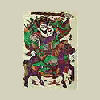Poniżej ciekawy artykuł o yiquan, taiki-ken i Kenichi Sawai'u.
Grandmaster Kenichi Sawai
Taiki-Ken: The essence of KungFu
By: Henk Verschuur
Grandmaster Kenichi Sawai was born in Fukuoka Prefecture in 1903 and would become one of the most renowned martial arts master of his time. After years of studying the classics of Japanese Martial Arts master Sawai decided that it was time to get involved in the Chinese disciplines.
His first steps in China took him to hard confrontation with well known kung-fu specialist whom he challenged for a fight.
At one of these occasion he met master Wang and although master Wang looked fragile the young Kenichi wasn't able of even hit the man.
In one of his attempt, of attacking master Wang, Kenichi was struck at his chest and it felt like being stung in the hart, poor Kenichi shivered and was filled with fear.
Then Kenichi tried to attack master Wang with a short stick and still it had no effect at all,
filled with doubt about his knowledge and capabilities he didn't eat for days.
He decided to become a student of this mysterious teacher, the art was called YIQUAN.
His tutor at the beginning was master Yao Zongxun ,who later would be the formal successor of master Wang , but Sawai Sensei was a fast learner and soon he followed the classes of the grandmaster himself.
Often the top students would get their teachings in the garden of grandmaster Wang which was common in the old days. Nowadays some do doubt about the fact whether or not Sawai Sensei was personally tutored by grandmaster Wang but there are many convincing statements that he really did, witnesses of that time wrote that he even would bring food as a present for his master.
Six years were gone by and Sawai Sensei heard about the awesome defeat of Japan during the second World War, in his mind there was only one solution, honorable suicide. Fortunately grandmaster Wang could stop him and convinced loyal young man to go back to his home grounds.
When Sawai Sensei returned to Japan he didn't rest but started to train at the famous dojo of
Oyama Sensei and in later days he would even teach some of Oyama's students,
at the same time he started to teach Yiquan in the Shibuya prefecture of Tokyo.
In those days all trainings were traditional and even for the Japanese insiders Sawai's trainings methods were unusual, none of them had ever seen ritsu-zen (standing zen), which is one of the basic stance of Yiquan, nor one of the others movements.
But there were also many appealing items in the training like the very hard sparring and the
realistic approach and this was well understood in the range of the fighting spirit of Japan.
Still far in his sixties nobody was able to beat the grandmaster, his strength during matches astonished the spectators and participants, the matches were a traditional way of competing and was called "Dojo-Yaburi".
One of his opponents told everybody who was willing to listen :"When I saw him fighting it looked very slow to me but when I fought him, even on a good distance(ma-ai), his movements were so fast that my eyes couldn't catch up with it. Also his kick looked quiet simple but I was never able to escape from them and they did really hurt."
On the 16th july 1988 Sawai Sensei died but his Yiquan survived and he left us a book called
"Taiki-ken: The essence of Kung-Fu"
For all you martial artist and fighters, try to find this old book and you will find some treasures of beauty and efficiency.

Yiquan, taiki-ken, Kenichi Sawai
Rozpoczęty przez , Ponad rok temu
Brak odpowiedzi do tego tematu
Użytkownicy przeglądający ten temat: 1
0 użytkowników, 1 gości, 0 anonimowych
 FaceBook
FaceBook
10 następnych tematów
-
 fajne teksty
fajne teksty- Ponad rok temu
-
 Pan Chingfu
Pan Chingfu- Ponad rok temu
-
 Bajiquan
Bajiquan- Ponad rok temu
-
 szukam
szukam- Ponad rok temu
-
 Styl pijanego?
Styl pijanego?- Ponad rok temu
-
 Choy Lee Fut w Warszawie - prawda to?
Choy Lee Fut w Warszawie - prawda to?- Ponad rok temu
-
 shuai chiao
shuai chiao- Ponad rok temu
-
 Jaki taijichuan?
Jaki taijichuan?- Ponad rok temu
-
 Wiem, ale nie powiem... Mistrzowie: otwartość czy tajemnica.
Wiem, ale nie powiem... Mistrzowie: otwartość czy tajemnica.- Ponad rok temu
-
 Krzysztof Kęsek - kto to?
Krzysztof Kęsek - kto to?- Ponad rok temu




